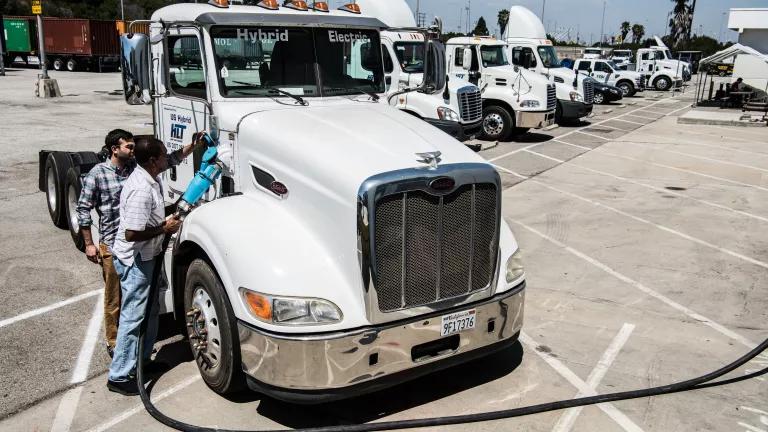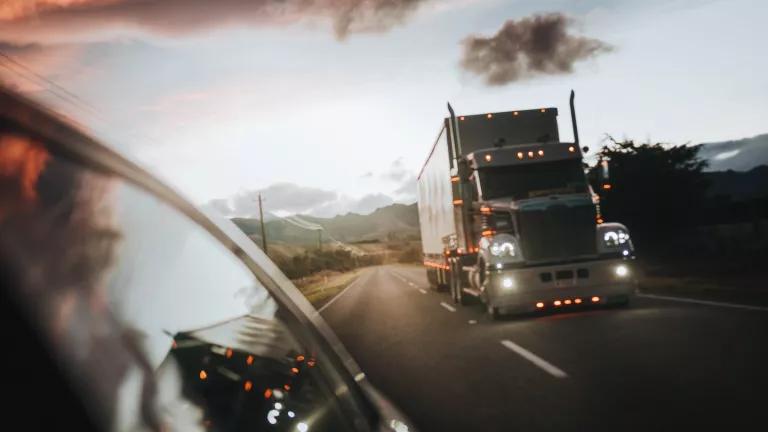Big Win: Oregon Moves Ahead on Clean Fuel Standard, Building Momentum for West Coast Clean Fuel Corridor
Oregon just clinched a spot in the clean energy future by becoming the second state, after California, to reduce carbon pollution from cars, trucks and buses through a new standard for clean, low-carbon fuel. Under Oregon's clean fuels program, carbon pollution from vehicle fuels would drop 10 percent over 10 years as petroleum is displaced by cleaner alternatives.
This is a big environmental victory, and a welcome win at a time when many state legislatures are advocating big polluter agendas. NRDC and our affiliate group of business leaders, E2, have been working with partners in Oregon for years to push clean fuels legislation through. It's a move that will not only benefit Oregon but could have ripple effects nationwide.
California and the Canadian province of British Columbia have already adopted a clean fuels standard, and Washington State is considering one as well. If Washington is able to capitalize on Oregon's momentum, it would create a corridor of clean fuel demand encompassing more than 50 million people up and down the length of the West Coast, equivalent to the 5th largest economy in the world. That's a big market signal that could help loosen the stranglehold of oil on our transportation sector.
For more than 100 years, we've relied almost exclusively on petroleum to get around. When you pull up to the pump, you don't have options. If oil prices are high, if it's a smoggy day, if you're sick of the extreme weather that's being driven by climate pollution, you still have to shell out money for polluting fossil fuels to get where you need to go. (Unless you have an electric car, can safely ride a bike, or have great public transportation--the exception, not the rule, in most of the country.)
Without clean fuel programs, transportation fuels are likely to get even dirtier over time. Globally, for every dollar the oil industry invests in finding and producing new (and often dirtier) sources of crude oil, it invests less than half a penny in cleaner renewable fuels. A low carbon fuel standard (LCFS) shakes up the status quo. It's a flexible, performance-based tool that doesn't pick technology winners or products, so it drives innovation and investment in clean alternatives across the board. Oil companies can meet the standard by investing in clean fuel production, blending in cleaner fuels produced by others, or by buying clean fuel credits that incentivize electric vehicles or other clean fuel alternatives.
In California, the LCFS has been working for four years. Despite continued opposition and litigation by the oil industry, the program has already increased the supplies of cleaner fuels and has resulted in ten million tons of reductions in carbon pollution - the equivalent of avoiding the annual emissions from more than 2 million cars and trucks.
A study conducted by ICF International and sponsored by a coalition of clean fuel producers, utilities, clean energy investors, and E2 showed that the cumulative benefits of California's program - in terms of avoided carbon pollution, air quality benefits, and increased energy security - was between $1.4 to $4.8 billion by 2020.
What's more, clean fuel programs can also bring in private investment and create jobs in the growing clean energy economy. In California, according to E2, the LCFS has brought in approximately $4 billion in private investment in advanced biofuels alone. That's investment only in sustainable fuels from plants--not hydrogen, electric vehicles or other clean fuel alternatives.
Several clean energy companies have expressed interest in setting up shop in the Pacific Northwest, citing low carbon fuel standards as a reason. Oregon's 10-year long clean fuel program will help provide new businesses and investors the market certainty they need to move forward. Oregon business leaders have applauded the program, which is projected to create up to 29,000 jobs in Oregon.
The oil industry spent millions of dollars lobbying against clean fuels programs in Oregon and elsewhere. They created 16 fake front groups purporting to represent consumers opposed to the standards. But at the end of the day, smart policy won. A clean, low-carbon fuel standard is a smart tool for tackling carbon pollution that will spark innovation in cleaner fuels and spur economic growth. If more states take advantage of this tool--perhaps Washington, perhaps the Northeastern states already working together to reduce power plant pollution through RGGI, the Regional Greenhouse Gas Initiative--the benefits would amplify nationwide.
According to the International Council on Clean Transportation, if the entire U.S. Pacific coast acts together on a low carbon fuel standard, it would reduce carbon emissions 14 to 21 percent and petroleum use up to 25 percent by 2030.
With results like that, states don't need to wait for the federal government to act.



